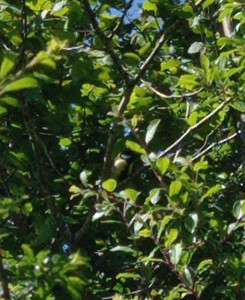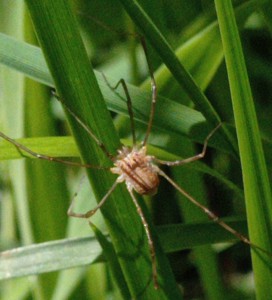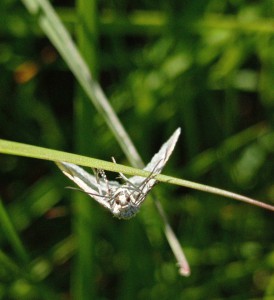A mixture of sunshine and showers this month have encouraged lots of flower blossoms, new growth and long grass. We have been clearing blackthorn from the main tree planting areas. We have also pulled some bracken. During the spring and summer, we ensure we do no work that will disturb nesting birds.  Birds seen and heard this month include, garden warbler, willow warbler, rook, buzzard, blackbird, robin, chiff chaff, dunnock, chaffinch, song thrush, blackcap, red kite, great tit, coal tit, blue tit, rook, crow and wren.
Birds seen and heard this month include, garden warbler, willow warbler, rook, buzzard, blackbird, robin, chiff chaff, dunnock, chaffinch, song thrush, blackcap, red kite, great tit, coal tit, blue tit, rook, crow and wren.
The dainty and very pretty green lacewings (Chrysopa perla) are flying around. The harvestman spider is abundant.  The viburnum beetle lava have been very active on one area of guelder rose, eating large chunks from the leaves. This species can be a pest but as we have so many guelder roses we don’t envisage a big problem. The Panorpa communis is one of the UK’s few scorpion flies – its curved tail (which gives it its common name) looks like a sting but it is the male’s claspers used for mating. The emperor dragonfly has been seen flying over the wildflower meadows.
The viburnum beetle lava have been very active on one area of guelder rose, eating large chunks from the leaves. This species can be a pest but as we have so many guelder roses we don’t envisage a big problem. The Panorpa communis is one of the UK’s few scorpion flies – its curved tail (which gives it its common name) looks like a sting but it is the male’s claspers used for mating. The emperor dragonfly has been seen flying over the wildflower meadows.
A lovely surprise was spotting a hummingbird hawk moth. It seemed to be taking nectar for the flowers on the large patch of red campion at the car park entrance. Usually, we see this moth feeding on red valerian. Other moths and butterflies seen include straw dot, silver ground carpet, dingy footman, common carpet, marbled white spot, grass rivulet (a local, tiny white moth that frequents wildflower meadows) red admiral, meadow brown, ringlet, large white, small skipper, small heath, speckled wood, peacock and a male Longhorm nemophora degeerella. Its antennae are about 4 times longer than this tiny moth’s body. The female has a much shorter antenna. It is quite common and can be seen dancing in the sunshine among the trees.
Its antennae are about 4 times longer than this tiny moth’s body. The female has a much shorter antenna. It is quite common and can be seen dancing in the sunshine among the trees. A lava of a drinker moth was found and photographed by James, who helps with the land management.
A lava of a drinker moth was found and photographed by James, who helps with the land management.
The tiny micro moths are abundant. Having looked for the tiny micro moth, C. fibulella on the extensive patches of speedwell here, this year was the first time we have seen them. We have spotted 6 so far. In the buttercup flowers we have found Micropterix calthella, with its metallic bronzy forewings and Cocksfoot (Glyphipterix simpliciella) with its silvery-white streaks. These tiny moths can be seen better using close focus binoculars. The tiny caterpillars feed on the seeds of their foodplant, which is mainly cock’s foot (Dactylis glomerata) grass. When fully grown, the larvae will enter the stems of grass to pupate. Infested stems can be detected by the presence of small holes along their length.
 It is wonderful to see the yellow rattle spreading. We sprinkled seeds in several areas last year. There are now many patches in the meadows and some in the woodland areas of grass, particularly alongside the paths. This species is a hemi-parasite (meaning partially parasitic)
It is wonderful to see the yellow rattle spreading. We sprinkled seeds in several areas last year. There are now many patches in the meadows and some in the woodland areas of grass, particularly alongside the paths. This species is a hemi-parasite (meaning partially parasitic)
on grasses and some legume herbs, such as clovers. As it weakens the grasses it allows other wildflowers to flourish so is an excellent plant for the wildflower meadows. The seeds germinate in early spring. It flowers May to July and sets its seeds in July and August, after that it dies. The new seeds continue the cycle the following year. It does need to have some space to grow within the grass sward.
Alt-y-garreg is a 20-acre nature reserve created in 2010 from four fields that had been improved pasture. There are areas of new woodland (over eighteen thousand trees of eighteen native species), wildflower meadows, scrub and ancient hedgerows. Two of the fields are now a natural burial site. The area is teeming with wildlife.
